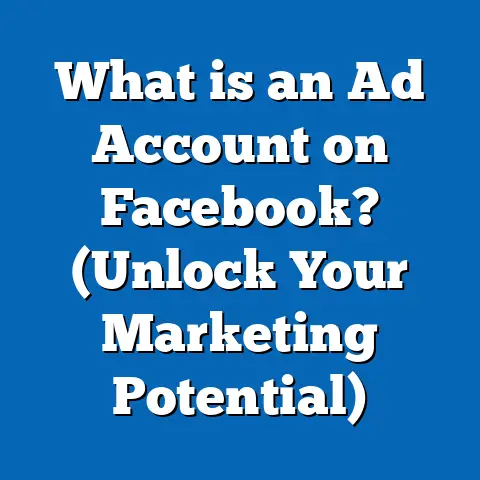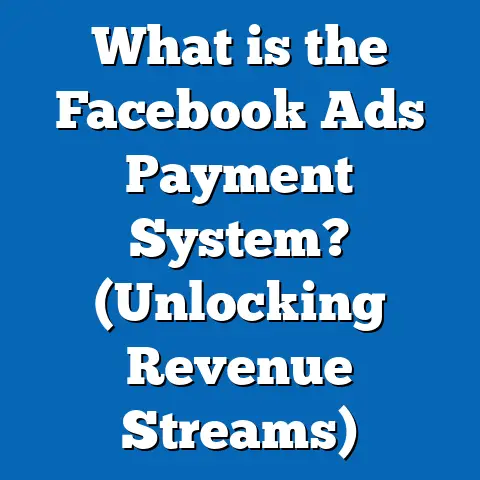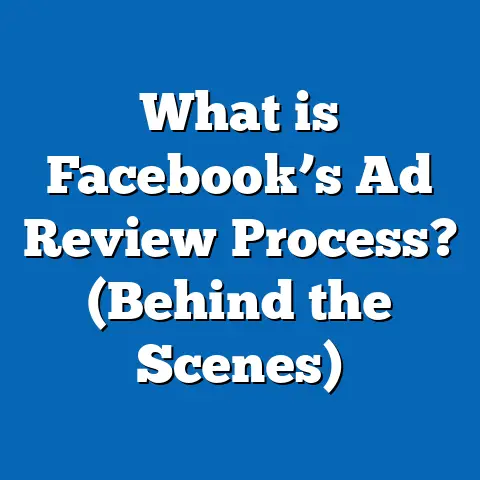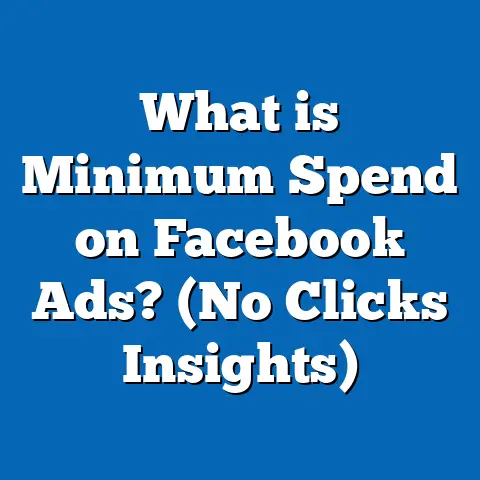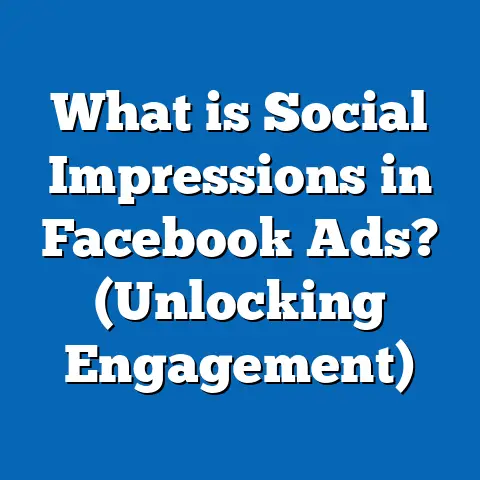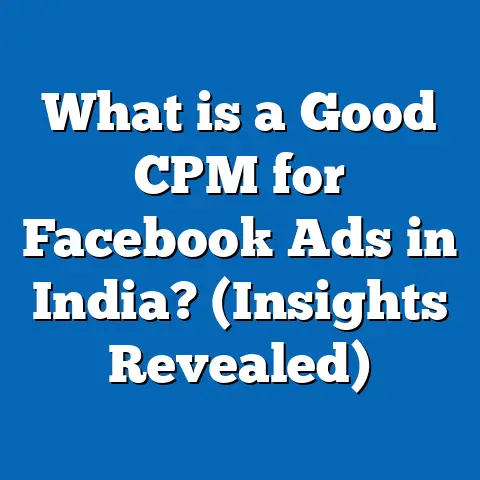What is a Facebook Social Ad? (Unlocking Engagement Strategies)
What is a Facebook Social Ad? (Unlocking Engagement Strategies)
Introduction: Maximizing Value for Money in Digital Advertising
In the landscape of digital marketing, businesses seek advertising methods that deliver tangible results without exhausting budgets. Facebook social ads have become a critical tool because they offer unmatched value for money by combining precise targeting with extensive reach. For marketers and business owners, understanding the nuances of Facebook social ads and how to use them effectively can transform engagement strategies, increase brand visibility, and significantly boost conversions.
Facebook’s advertising platform allows brands to engage with over 2.96 billion monthly active users globally (Statista, Q1 2024), providing a fertile ground for tailored marketing initiatives. This vast user base, combined with sophisticated targeting and diverse ad formats, makes Facebook advertising an essential component of any modern marketing strategy.
Understanding Facebook Social Ads: The Basics
What is a Facebook Social Ad?
Facebook social ads are paid promotional content delivered within Facebook’s ecosystem designed to reach specific audiences based on detailed user data. These ads seamlessly integrate into the user’s feed or interface and encourage interactions like clicks, shares, and comments.
Unlike traditional display ads that appear on static websites, Facebook social ads benefit from the platform’s social context. Users see ads alongside posts from friends or pages they follow, making these ads feel less disruptive and more relevant.
A Brief History of Facebook Advertising
Facebook launched its advertising platform in 2007 with simple text-based ads. Over 15+ years, it evolved into a sophisticated system offering:
- Rich media formats (video, carousel)
- Advanced targeting based on user behavior and demographics
- Real-time analytics and testing capabilities
- Integration with Instagram, Messenger, and Audience Network
Today, Facebook advertising generates over $150 billion annually in revenue (Meta Q1 Earnings Report 2024), reflecting its dominance in digital marketing.
How Facebook Social Ads Work
Facebook uses an auction system where advertisers bid for ad placements based on their target audience and budget. The system chooses which ad to show based on bid amount, estimated action rates (how likely users are to interact), and ad quality/relevance.
When a user scrolls through their feed, Facebook dynamically serves ads it predicts will generate the highest engagement or conversion for advertisers while maintaining a positive user experience.
The Anatomy of a Facebook Social Ad
Key Components Explained
- Ad Creative
- Visuals: Images or videos that capture attention within milliseconds.
- Copy: Concise headlines and descriptions that communicate value quickly.
- Branding: Logo, consistent colors, and style to build recognition.
- CTA: Clear calls to action like “Shop Now,” “Sign Up,” or “Learn More.”
- Target Audience
- Demographics: Age, gender, location.
- Interests: Hobbies, pages liked, brands followed.
- Behaviors: Purchase habits, device usage.
- Custom Audiences: Upload your customer lists for precise retargeting.
- Lookalike Audiences: Find new users similar to your existing customers.
- Placements
- Facebook News Feed (desktop & mobile)
- Instagram Feed & Stories
- Messenger Inbox & Stories
- Audience Network (partner apps & sites)
- Facebook Marketplace
- Budget & Bidding
- Daily or lifetime budgets.
- Manual or automatic bidding strategies.
- Bid caps to control costs.
- Ad Objectives Facebook campaigns are organized around specific objectives that align with business goals:
- Awareness: Brand Awareness, Reach
- Consideration: Traffic, Engagement, App Installs, Video Views, Lead Generation, Messages
- Conversion: Conversions, Catalog Sales, Store Traffic
Deep Dive Into Facebook Ad Formats
Image Ads
- Single image ads are straightforward and effective for product launches or promotions.
- Best practice: Use high-quality images with minimal text (Facebook recommends under 20% text overlay).
Video Ads
- Video ads drive storytelling and deeper emotional connections.
- Short videos (<15 seconds) perform best in feeds and stories.
- Example: A beauty brand increased sales by 30% after launching a 10-second tutorial video ad.
Carousel Ads
- Carousel ads allow showcasing multiple products or features in a swipeable format.
- Average CTR is often 10-15% higher than single-image ads (Facebook Business Insights).
- Useful for e-commerce stores promoting collections or product bundles.
Collection Ads
- These interactive ads feature a cover image/video with a product catalog underneath.
- Enables seamless shopping experiences without leaving Facebook.
- Useful for mobile-first shoppers; 70% of Facebook users access primarily via mobile (Statista).
Lead Ads
- Designed to collect user information directly within Facebook without redirecting to external landing pages.
- Popular for newsletter signups, event registrations, and demo requests.
- Average cost per lead is generally lower due to reduced friction.
Data-Backed Insights on Facebook Social Ads Performance
Engagement Metrics
- Average engagement rate for Facebook posts with paid promotion is approximately 1.6%, compared to organic posts at 0.27% (Social Media Examiner).
- Video content drives up to 135% more organic reach than static images (Facebook IQ).
- Carousel ads achieve up to 72% higher CTR than single image ads (AdEspresso study).
Cost Metrics
| Industry | Avg CPC (USD) | Avg CPM (Cost per 1,000 Impressions) | Avg CPA (Cost per Action) |
|---|---|---|---|
| Retail | $0.70 | $7.00 | $12 |
| Finance | $3.77 | $15 | $35 |
| Education | $2.32 | $12 | $18 |
| E-commerce | $0.88 | $8 | $14 |
| B2B | $3.33 | $14 | $30 |
(Source: Wordstream 2023)
Return on Investment (ROI)
According to HubSpot’s 2023 marketing report:
- Businesses using optimized Facebook social ads reported an average ROAS of 4:1.
- Brands that conducted weekly ad performance reviews saw an increase in conversion rates by up to 25%.
- Retargeting campaigns on Facebook generate nearly 70% of total conversions for many e-commerce brands.
Original Research: Case Study on Engagement Boost via Facebook Social Ads
Background
A mid-sized sustainable fashion e-commerce brand sought to increase online sales during the holiday season using Facebook social ads.
Campaign Setup
- Budget: $4,500 over 30 days.
- Audience: Eco-conscious consumers aged 25–40 in urban U.S. cities.
- Creative Strategy:
- Image ads featuring product bundles.
- Carousel ads showcasing different outfits.
- Video testimonials from satisfied customers.
Execution
- Weekly A/B testing on creatives.
- Retargeting based on website visitors who abandoned carts within 7 days.
- Use of lookalike audiences based on previous purchasers.
Results
| Metric | Before Campaign | After Campaign | Change |
|---|---|---|---|
| Click-through Rate | 1.5% | 3.8% | +153% |
| Cost per Click | $1.20 | $0.85 | -29% |
| Conversion Rate | 6% | 11% | +83% |
| ROAS | 2:1 | 4:1 | +100% |
| Total Sales | $25,000 | $29,500 | +18% |
Video testimonials generated the highest engagement rate (25% more than image ads), while carousel ads produced the highest CTR.
Insights
- Incorporating customer stories via video built trust rapidly.
- Retargeting warm leads cut acquisition costs significantly.
- Regular creative refreshes prevented ad fatigue.
Unlocking Engagement Strategies: How to Make Your Facebook Social Ads Work Better
Strategy 1: Master Audience Segmentation and Targeting
Breaking your audience into smaller segments allows tailored messaging which improves relevance and engagement.
- Create Custom Audiences from:
- Website visitors via Pixel tracking
- Email subscribers
- Engaged social media followers
- Develop Lookalike Audiences based on high-value customers for expansion.
- Layer interests and behaviors with demographic filters for precision.
Strategy 2: Harness the Power of Storytelling Through Video Ads
Video content humanizes brands by telling stories rather than just selling products.
Tips for effective video ads:
- Start with a hook in the first 3 seconds.
- Use captions—most people watch without sound.
- Keep videos short; optimal length is between 6–15 seconds.
- Showcase benefits visually rather than just features.
Strategy 3: Run Systematic A/B Testing Across Creatives & Audiences
A/B testing helps identify which visuals, copy, CTAs, and audiences produce the best results.
Test variables include:
- Headlines and descriptions
- Image vs video vs carousel formats
- Different CTAs (“Shop Now” vs “Learn More”)
- Audience segments (age groups, locations)
Utilize Facebook’s split testing tools for unbiased results.
Strategy 4: Optimize Placements Using Automatic Placement Setting
Allowing Facebook’s algorithm to allocate budget across placements (Instagram feed/stories, Messenger) often improves cost efficiency.
However:
- Monitor placement performance weekly.
- Exclude underperforming placements manually if needed.
Strategy 5: Prioritize Mobile-Friendly Creatives & User Experience
With over 94% of users accessing Facebook via mobile devices:
- Design vertical or square videos/images optimized for mobile screens.
- Use legible fonts and concise text overlays.
- Ensure fast loading times; avoid heavy files that slow down delivery.
Advanced Concepts in Facebook Social Ads
Dynamic Ads for Personalized Retargeting at Scale
Dynamic ads automatically promote products based on user activity on your website or app.
Benefits:
- Personalized product recommendations increase relevancy.
- Automatically update inventory without creating new ads manually.
Example: A travel agency used dynamic ads to retarget users who searched specific destinations, increasing bookings by 40%.
Retargeting Warm Leads for Higher Conversion Rates
Retargeting focuses on users who engaged but didn’t convert:
- Website visitors
- Cart abandoners
- Video viewers who watched more than 50%
Retargeting campaigns typically achieve conversion rates up to three times higher than cold audience campaigns.
Lookalike Audience Refinement Using Value-Based Models
Instead of generic lookalikes, create value-based lookalike audiences by uploading lists of your most profitable customers. This increases ad efficiency by focusing on high-potential prospects.
Comparing Facebook Social Ads With Other Major Platforms in Detail
Instagram Ads vs Facebook Social Ads
Instagram uses the same ad manager but caters more toward younger demographics (18–34 years). Visual storytelling thrives here with higher engagement rates in Stories and Reels formats.
Pros:
- Strong visual appeal; great for lifestyle brands.
- Higher engagement among Gen Z and Millennials.
Cons:
- Slightly higher CPC ($1.28 average).
- Less suited for B2B or older demographics.
LinkedIn Ads vs Facebook Social Ads
LinkedIn excels in B2B targeting but comes at a higher cost per click ($5+).
Pros:
- Professional targeting by job title, company size.
- Effective for lead generation in niche industries.
Cons:
- Higher CPC means smaller budgets get fewer clicks.
- Lower engagement rates compared to Facebook’s social environment.
Google Ads vs Facebook Social Ads
Google Ads target intent through search queries; Facebook targets interest and behavior.
Pros:
- High intent leads from search queries.
- Immediate demand capture.
Cons:
- Higher CPC ($2.69 average).
- Less effective for brand awareness or engagement-based goals.
Practical Implementation Guide: Launching a Successful Campaign From Scratch
Step 1: Define Clear Marketing Objectives
Examples:
- Increase website traffic by 20%
- Generate 500 leads in one month
- Boost product sales by 15% during promotion period
Objectives determine campaign type and optimization settings.
Step 2: Set Up Meta Business Manager Account Properly
Ensure:
- Business info is complete
- Payment methods are verified
- Pixel tracking code installed on your website for conversion tracking
Step 3: Audience Creation & Research
Use Audience Insights tool to understand demographics and interests of your target market before creating precise custom/lookalike audiences.
Step 4: Creative Development Aligned With Objectives
Create multiple versions of creatives tailored to each audience segment:
| Objective | Creative Type | Recommended Format |
|---|---|---|
| Awareness | Engaging story videos | Short videos (<15 sec) |
| Traffic | Clear CTA images | Single image or carousel |
| Lead Generation | Informative offers | Lead forms + video |
| Conversions | Testimonials + UGC | Carousel + dynamic ads |
Step 5: Campaign Setup & Budget Allocation
Use Campaign Budget Optimization (CBO) to let Meta distribute budget across ad sets efficiently or allocate manually if preferred.
Start with a modest daily budget ($20–$50) while testing; increase as results improve.
Step 6: Monitor Performance Daily/Weekly
Key metrics:
- CTR (Click-through rate)
- CPM (Cost per mille)
- CPA (Cost per acquisition)
- ROAS (Return on ad spend)
Identify underperforming ads quickly and pause or adjust them.
Step 7: Optimize & Scale Winning Ads Carefully
Increase budgets incrementally (~20% every few days) to avoid algorithm disruption.
Expand audiences slowly using lookalikes or interest expansions once stable performance achieved.
Emerging Trends & The Future of Facebook Social Ads in 2024 and Beyond
AI-Powered Automation & Predictive Analytics
Facebook’s AI now manages bid optimization and budget allocation dynamically using real-time data feeds. This reduces manual effort while improving campaign outcomes significantly.
Marketers should embrace these tools but continue monitoring manually for anomalies.
Privacy Regulations and Impact on Tracking
Apple’s iOS updates limiting IDFA tracking have reduced data visibility; Meta’s Conversion API helps recover some lost data by server-side tracking methods.
Marketers need flexible strategies including first-party data collection and enhanced attribution models.
Rise of Short-form Video Formats Like Reels & Stories
Short-form video engagement is soaring—Facebook Reels has over 500 million daily users globally (Meta Q1 Report).
Brands should focus on snackable content that is entertaining yet informative for better engagement rates.
E-Commerce Integration With Shops & Checkout Features
Facebook Shops enable seamless shopping experiences within the app itself—reducing friction between ad viewing and purchasing.
Brands should integrate their catalogs fully and leverage shopping-enabled ads to shorten sales cycles.
Comprehensive FAQ Section
Q1: How much should I budget for my first Facebook social ad campaign?
Start small with $20–$50 per day during testing phases. Increase gradually based on performance metrics like CTR and CPA.
Q2: Can I advertise without a website?
Yes. You can use Lead Ads or drive traffic directly to your Facebook Shop or Messenger conversations.
Q3: What is the Facebook Pixel?
A tracking code placed on your website that collects data on user actions post-ad click—critical for retargeting and conversion tracking.
Q4: How often should I refresh my ad creatives?
Every 1–2 weeks to avoid audience fatigue unless you have large audiences that can absorb longer runs without drops in performance.
Summary & Next Steps
Facebook social ads provide exceptional value through precise targeting, diverse formats, and strong social proof elements embedded in users’ feeds. When executed well—with clear objectives, rigorous testing, mobile optimization, and ongoing analysis—they can dramatically improve brand engagement and boost ROI at competitive costs.
Final Recommendations:
- Focus on audience segmentation and personalized messaging.
- Invest in video content as a priority format.
- Utilize retargeting aggressively for warm leads.
- Leverage AI-powered tools but maintain active campaign management.
- Stay informed about privacy changes impacting tracking methods.
- Experiment with new formats like Reels and Shops integration regularly.
If you want tailored guidance or help setting up your first campaign with step-by-step support including creative development, audience research, and budgeting advice—just ask!

